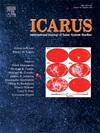利用乌托邦平原的HiRISE图像提取火星岩石的一种新的marsrock - fastrcnn方法
IF 2.5
2区 物理与天体物理
Q2 ASTRONOMY & ASTROPHYSICS
引用次数: 0
摘要
火星表面的岩石是其地貌的重要特征,岩石丰度是选择着陆点的关键考虑因素,也是着陆点工程安全的关键考虑因素。在这项研究中,我们提出了一种基于更快r - cnn的智能提取方法(即MarsRock-FasterRcnn),用于从MRO轨道飞行器上的高分辨率成像相机(HiRISE)获取的图像(0.25 m/像素)中检测火星岩石。MarsRock-FasterRcnn方法可以在HiRISE图像上提取直径0.5-2 m的岩石。我们建立了一个包含2000张大小为416 × 416的岩石样本集来训练MarsRock-FasterRcnn模型,最后使用精度、召回率和F1分数等评估指标来评估模型的预测效果。结果表明,该模型的查全率和查准率均在80%左右,最大置信度在99%以上,表明该模型具有良好的性能。对乌托邦平原岩石的提取和验证表明,大部分地区岩石丰度在7%以下,南部地区整体岩石丰度在5%以下,表明着陆时岩石障碍物的影响较弱。我们还发现岩石丰度和地形之间有很强的关系,岩石丰度越高,地形起伏越大。该研究可以为研究火星地形和地质提供科学线索,也可以为探测任务的着陆点选择提供工程约束。本文章由计算机程序翻译,如有差异,请以英文原文为准。
A new MarsRock-FasterRcnn method to extract Mars rocks using HiRISE images at Utopia Plainitia
Rocks on Mars' surface are an important feature of its geomorphology, and rock abundance is a key consideration for the selection of landing sites, as well as the engineering safety of the landing. In this study, we proposed a Faster R-CNN-based intelligent extraction method (i.e., MarsRock-FasterRcnn) for detecting Mars rocks from images (0.25 m/pixel) acquired by the High-Resolution Imaging Camera (HiRISE) onboard the MRO orbiter. MarsRock-FasterRcnn method can extract rocks with diameter of 0.5–2 m on HiRISE images. We built a rock sample set containing 2000 images of size 416 × 416 to train the MarsRock-FasterRcnn model, and finally evaluated the prediction effect of the model using assessment metrics including precision, recall, and F1 score. The results showed that the recall and precision were both about 80 %, and the maximum confidence was above 99 %, indicating excellent model performance. The extraction and validation of rocks in Utopia Plainitia show that the rock abundance is below 7 % in most of the region, and the overall rock abundance in the southern part of the region is below 5 %, indicating weaker effects by the rocky obstacles when landing. We also found a strong relationship between the rock abundance and topography, where a higher rock abundance relates to a greater topographic undulation. This study can provide scientific clues for the investigation of the topography and geology of Mars, as well as engineering constraints for the selection of landing sites for exploration missions.
求助全文
通过发布文献求助,成功后即可免费获取论文全文。
去求助
来源期刊

Icarus
地学天文-天文与天体物理
CiteScore
6.30
自引率
18.80%
发文量
356
审稿时长
2-4 weeks
期刊介绍:
Icarus is devoted to the publication of original contributions in the field of Solar System studies. Manuscripts reporting the results of new research - observational, experimental, or theoretical - concerning the astronomy, geology, meteorology, physics, chemistry, biology, and other scientific aspects of our Solar System or extrasolar systems are welcome. The journal generally does not publish papers devoted exclusively to the Sun, the Earth, celestial mechanics, meteoritics, or astrophysics. Icarus does not publish papers that provide "improved" versions of Bode''s law, or other numerical relations, without a sound physical basis. Icarus does not publish meeting announcements or general notices. Reviews, historical papers, and manuscripts describing spacecraft instrumentation may be considered, but only with prior approval of the editor. An entire issue of the journal is occasionally devoted to a single subject, usually arising from a conference on the same topic. The language of publication is English. American or British usage is accepted, but not a mixture of these.
 求助内容:
求助内容: 应助结果提醒方式:
应助结果提醒方式:


